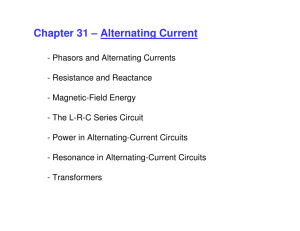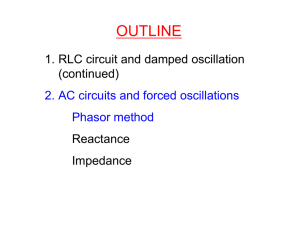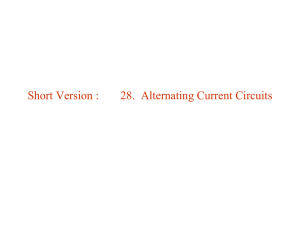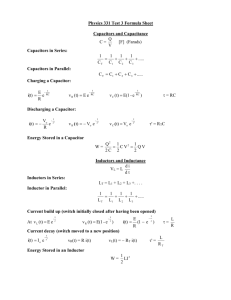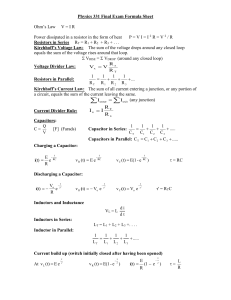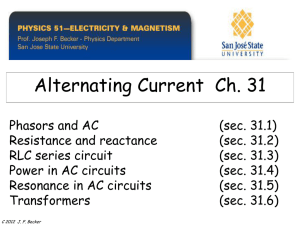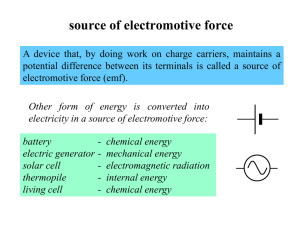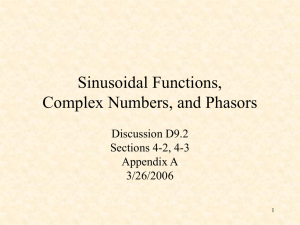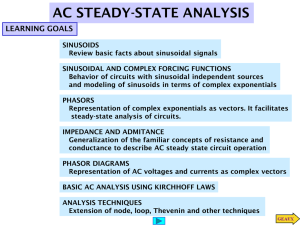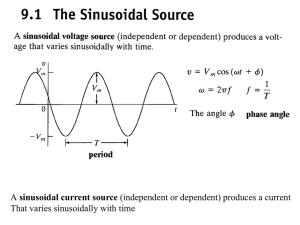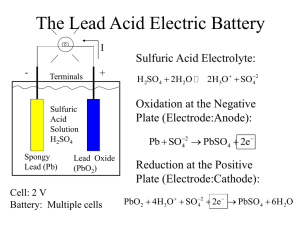Crystal Ball - UCF Physics
advertisement
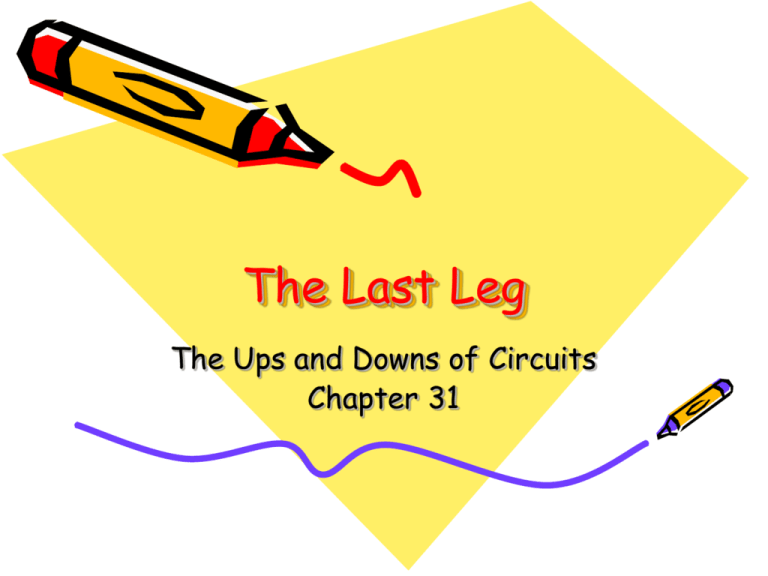
The Last Leg The Ups and Downs of Circuits Chapter 31 The End is Near! • Examination #3 – Friday (April 15th) • Taxes Due – Friday (April 15th) • Watch for new WebAssigns • Final Exam is Wednesday, April 27th. • Grades will be submitted as quickly as possible. That’s Two Weeks. That’s Two Weeks. That’s Two Weeks. So far we have considered DC Circuits We looked at Resistors Capacitors Inductors Steady State DC behaviors Transient DC behaviors. We have not looked at sources that varied with time. Example LR Circuit sum of voltage drops 0 : i Steady Source di E iR L 0 dt same form as the capacitor equation q dq E R 0 C dt Time Dependent Result: E Rt / L i (1 e ) R time constant L R R L Variable Emf Applied 1.5 1 Volts emf 0.5 DC 0 0 1 2 3 4 5 6 7 8 -0.5 -1 Sinusoidal -1.5 Tim e 9 10 Sinusoidal Stuff emf A sin( t ) “Angle” Phase Angle Same Frequency with PHASE SHIFT Different Frequencies At t=0, the charged capacitor is connected to the inductor. What would you expect to happen?? The Math Solution: LC New Feature of Circuits with L and C These circuits produce oscillations in the currents and voltages Without a resistance, the oscillations would continue in an un-driven circuit. With resistance, the current would eventually die out. The Graph Note – Power is delivered to our homes as an oscillating source (AC) Producing AC Generator xxxxxxxxxxxxxxxxxxxxxxx xxxxxxxxxxxxxxxxxxxxxxx xxxxxxxxxxxxxxxxxxxxxxx xxxxxxxxxxxxxxxxxxxxxxx xxxxxxxxxxxxxxxxxxxxxxx xxxxxxxxxxxxxxxxxxxxxxx xxxxxxxxxxxxxxxxxxxxxxx xxxxxxxxxxxxxxxxxxxxxxx xxxxxxxxxxxxxxxxxxxxxxx xxxxxxxxxxxxxxxxxxxxxxx xxxxxxxxxxxxxxxxxxxxxxx xxxxxxxxxxxxxxxxxxxxxxx The Real World A The Flux: B A BA cos t emf BA sin t emf i A sin t Rbulb OUTPUT emf V V0 sin( t ) WHAT IS AVERAGE VALUE OF THE EMF ?? Average value of anything: T h T f (t )dt 0 h 1 h T T f (t )dt 0 T Area under the curve = area under in the average box Average Value T 1 V V (t )dt T0 For AC: T 1 V V0 sin t dt 0 T0 So … Average value of current will be zero. Power is proportional to i2R and is ONLY dissipated in the resistor, The average value of i2 is NOT zero because it is always POSITIVE Average Value T 1 V V (t )dt 0 T 0 Vrms V 2 RMS Vrms V02 Sin 2t V0 1 2 2 Sin ( t )dt T 0 T T 1 T 2 2 2 Sin ( t )d t T 2 0 T T T Vrms V0 Vrms V0 2 Vrms V0 2 2 V0 0 Sin ( )d 2 2 Usually Written as: Vrms V peak 2 V peak Vrms 2 Example: What Is the RMS AVERAGE of the power delivered to the resistor in the circuit: R E ~ Power V V0 sin( t ) V V0 i sin( t ) R R 2 2 V V 0 2 2 0 P (t ) i R sin( t ) R sin t R R More Power - Details 2 V02 V P Sin 2t 0 Sin 2t R R P P P P V02 R 2 V0 R V02 R V02 R 1 T 2 T Sin (t )dt 2 0 T 1 0 Sin 2 (t )dt 2 V 1 2 2 0 1 Sin ( )d 2 0 R 2 2 1 1 V0 V0 Vrms 2 R 2 2 R Resistive Circuit We apply an AC voltage to the circuit. Ohm’s Law Applies Consider this circuit e iR emf i R CURRENT AND VOLTAGE IN PHASE Alternating Current Circuits An “AC” circuit is one in which the driving voltage and hence the current are sinusoidal in time. V(t) Vp v 2 t V = VP sin (t - v ) I = IP sin (t - I ) -Vp is the angular frequency (angular speed) [radians per second]. Sometimes instead of we use the frequency f [cycles per second] Frequency f [cycles per second, or Hertz (Hz)] 2 f Phase Term V = VP sin (wt - v ) V(t) Vp v -Vp 2 t Alternating Current Circuits V = VP sin (t - v ) I = IP sin (t - I ) I(t) V(t) Ip Vp Irms Vrms v -Vp 2 t I/ t -Ip Vp and Ip are the peak current and voltage. We also use the “root-mean-square” values: Vrms = Vp / 2 and Irms=Ip / 2 v and I are called phase differences (these determine when V and I are zero). Usually we’re free to set v=0 (but not I). Example: household voltage In the U.S., standard wiring supplies 120 V at 60 Hz. Write this in sinusoidal form, assuming V(t)=0 at t=0. Example: household voltage In the U.S., standard wiring supplies 120 V at 60 Hz. Write this in sinusoidal form, assuming V(t)=0 at t=0. This 120 V is the RMS amplitude: so Vp=Vrms 2 = 170 V. Example: household voltage In the U.S., standard wiring supplies 120 V at 60 Hz. Write this in sinusoidal form, assuming V(t)=0 at t=0. This 120 V is the RMS amplitude: so Vp=Vrms 2 = 170 V. This 60 Hz is the frequency f: so =2 f=377 s -1. Example: household voltage In the U.S., standard wiring supplies 120 V at 60 Hz. Write this in sinusoidal form, assuming V(t)=0 at t=0. This 120 V is the RMS amplitude: so Vp=Vrms 2 = 170 V. This 60 Hz is the frequency f: so =2 f=377 s -1. So V(t) = 170 sin(377t + v). Choose v=0 so that V(t)=0 at t=0: V(t) = 170 sin(377t). Resistors in AC Circuits R E ~ EMF (and also voltage across resistor): V = VP sin (t) Hence by Ohm’s law, I=V/R: I = (VP /R) sin(t) = IP sin(t) (with IP=VP/R) V I 2 t V and I “In-phase” Capacitors in AC Circuits C Start from: q = C V [V=Vpsin(t)] Take derivative: dq/dt = C dV/dt So I = C dV/dt = C VP cos (t) E ~ I = C VP sin (t + /2) V I 2 t This looks like IP=VP/R for a resistor (except for the phase change). So we call Xc = 1/(C) the Capacitive Reactance The reactance is sort of like resistance in that IP=VP/Xc. Also, the current leads the voltage by 90o (phase difference). V and I “out of phase” by 90º. I leads V by 90º. I Leads V??? What the **(&@ does that mean?? 2 V 1 I I = C VP sin (t + /2) Current reaches it’s maximum at an earlier time than the voltage! Capacitor Example A 100 nF capacitor is connected to an AC supply of peak voltage 170V and frequency 60 Hz. C E ~ What is the peak current? What is the phase of the current? 2f 2 60 3.77 rad/sec C 3.77 10 7 1 XC 2.65M C Also, the current leads the voltage by 90o (phase difference). Inductors in AC Circuits ~ L V = VP sin (t) Loop law: V +VL= 0 where VL = -L dI/dt Hence: dI/dt = (VP/L) sin(t). Integrate: I = - (VP / L cos (t) or V Again this looks like IP=VP/R for a resistor (except for the phase change). I I = [VP /(L)] sin (t - /2) 2 t So we call the XL = L Inductive Reactance Here the current lags the voltage by 90o. V and I “out of phase” by 90º. I lags V by 90º. Phasor Diagrams A phasor is an arrow whose length represents the amplitude of an AC voltage or current. The phasor rotates counterclockwise about the origin with the angular frequency of the AC quantity. Phasor diagrams are useful in solving complex AC circuits. The “y component” is the actual voltage or current. Resistor Vp Ip t Phasor Diagrams A phasor is an arrow whose length represents the amplitude of an AC voltage or current. The phasor rotates counterclockwise about the origin with the angular frequency of the AC quantity. Phasor diagrams are useful in solving complex AC circuits. The “y component” is the actual voltage or current. Resistor Capacitor Vp Ip Ip t t Vp Phasor Diagrams A phasor is an arrow whose length represents the amplitude of an AC voltage or current. The phasor rotates counterclockwise about the origin with the angular frequency of the AC quantity. Phasor diagrams are useful in solving complex AC circuits. The “y component” is the actual voltage or current. Resistor Capacitor Inductor Vp Ip Vp Ip t Ip t t Vp i i + + + time i i LC Circuit i i + + + Analyzing the L-C Circuit 2 Total energy in the circuit: Differentiate : 1 2 1q U UB UE LI 2 2 C 2 dU d 1 2 1 q ( LI ) 0 N o change in energy dt dt 2 2 C dI q dq dq d 2 q q dq LI 0 L( ) 2 dt C dt dt dt C dt d 2q 1 L 2 q 0 dt C Analyzing the L-C Circuit 2 Total energy in the circuit: Differentiate : 1 2 1q U UB UE LI 2 2 C 2 dU d 1 2 1 q ( LI ) 0 N o change in energy dt dt 2 2 C dI q dq dq d 2 q q dq LI 0 L( ) 2 dt C dt dt dt C dt d 2q 1 L 2 q 0 dt C Analyzing the L-C Circuit 2 Total energy in the circuit: Differentiate : 1 2 1q U UB UE LI 2 2 C 2 dU d 1 2 1 q ( LI ) 0 N o change in energy dt dt 2 2 C dI q dq dq d 2 q q dq LI 0 L( ) 2 dt C dt dt dt C dt d 2q 1 L 2 q 0 dt C Analyzing the L-C Circuit 2 Total energy in the circuit: Differentiate : d 2q 2 q0 2 dt q q p cos t 1 2 1q U UB UE LI 2 2 C 2 dU d 1 2 1 q ( LI ) 0 N o change in energy dt dt 2 2 C dI q dq dq d 2 q q dq LI 0 L( ) 2 dt C dt dt dt C dt d 2q 1 L 2 q 0 dt C The charge sloshes back and forth with frequency = (LC)-1/2
